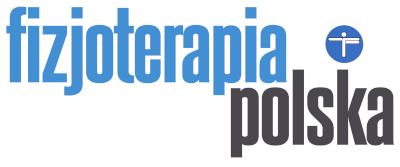Hamada A. Hamada, Hossam E. Fawaz, Ghada Koura, Noran A. Elbehary, Salam M. Elhafez
Hamada A. Hamada, Hossam E. Fawaz, Ghada Koura, Noran A. Elbehary, Salam M. Elhafez – Mechanical Response of Hip and Knee Muscles Following Randomized Crossover Trials in Patellofemoral Pain Syndrome. Fizjoterapia Polska 2020; 20(1); 160-168
Abstract
Background. Faulty hip kinematics during weight bearing activities is proposed to contribute to patellofemoral pain syndrome (PFPS). However, limited information exists to determine the effectiveness of exercises programs that not only act on the knee joint, but also on the hip joint in patients with PFPS. Purpose. The purpose of this study was to compare between the effect of the starting with hip strengthening exercises before knee exercises program and the starting with knee exercises program before hip strengthening exercises on pain intensity, Kujala questionnaire scale, quadriceps angle (Q-angle), anteversion angle, and eccentric peak torques (PT) for hip abductors, external rotators, and knee extensors in patients with PFPS. Materials and Methods. Twenty-four patients suffering from PFPS were randomly assigned into two equal groups of twelve. Group (A): their mean age, weight, height and BMI values were 23.33 ± 5.39 years, 71.16 ± 13.05 kg, 164.75 ± 4.5 cm, and 26.21 ± 4.71 kg/m² respectively. They received hip abductors and external rotators strengthening exercises for three weeks followed by knee extensors strengthening exercises and stretching exercises for hamstring quadriceps, iliotibial band and gastrocnemus for another three weeks. Group (B): their mean age, weight, height and BMI values were 23.16 ± 6.33 years, 69.41 ± 18.14 kg, 164.66 ± 7.27 cm, and 25.2 ± 6.2 kg/m² respectively. They received knee extensors strengthening exercises and stretching exercises for hamstring, quadriceps, iliotibial band and gastrocnemus for three weeks followed by hip abductors and external rotators strengthening exercises for another three weeks. Both groups received three to four sessions per week for six weeks. Pain level, Kujala scale, Q-angle, anteversion angle, and isokinetic eccentric PT for hip abductors, external rotators, and knee extensors were recorded before, after three weeks, and after six weeks of exercises. Results. 2×3 Mixed Design MANOVA revealed that there was a significant reduction in level of perceived pain and improvement of Kujala scale in group (A) compared with group (B) after six weeks of exercise (p < 0.05). However, there was no significant difference in the Q-angle, anteversion angle, and isokinetic eccentric PT for hip abductors, external rotators, and knee extensors between the tested groups after six weeks of exercise (p > 0.05). Conclusion. Starting rehabilitation program with hip strengthening exercises before knee exercises program is more effective than starting with knee exercises program before hip strengthening exercises in reducing pain and improving knee function in patients with PFPS. Consequently, this may help physiotherapists in designing the most effective and efficient prevention and rehabilitation programs for patients suffering from PFPS.
Key words:
Patellofemoral Pain Syndrome, Hip, Knee, Strengthening Exercises, Q -Angle, Anteversion Angle

